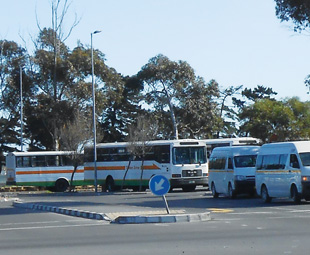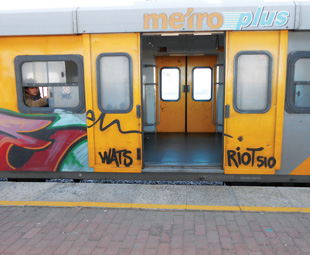Saving Cape Town from congestion

Public transport could be the solution to traffic congestion. In this first article in a series of four, MARISKA MORRIS speaks with experts about solving the issue
Cape Town once again surpassed Johannesburg as the most congested city in South Africa for the fifth year running. The TomTom Traffic Index 2017 estimates that Capetonians spend an extra 163 hours (or six days) on travel every year. Aside from the frustration and stress that traffic congestion causes the driver, the economy loses money, too.
Civil engineer at the Univeristy of Cape Town, Associate Professor Marianne Vanderschuren, a specialist on public transport, uses the April 2016 arson attacks on Metrorail as an example of economic losses.
“If we assume that everybody in Cape Town works one hour less because of the arson, that would cost the Cape Town economy more than R450 million,” she explains.
The congestion in Cape Town is caused by population growth and mobility – more people moving around more frequently. There was a 2,5-percent increase in the population (approximately 1,3-million people) in the last decade. Economic advancements resulted in a five-percent increase in mobility with five-million people travelling more often.
This increase in population and mobility requires increased road space. However, the city has not kept up with the growth, and building more roads will not necessarily resolve the issue. “What we need to remember is that building more roads is not going to remove the congestion. You can’t build your way out of congestion,” Vanderschuren argues.
More roads simply lead to more cars and drivers. She suggests improved public transport as a solution to Cape Town’s congestion crisis.
Why public transport?
 The Metrorail trains and MyCiTi bus rapid transit (BRT) system (with its dedicated lanes) result in a shorter commute. They transport large numbers of people leading to fewer cars and less congestion. Public transport also addressess the current travel inequalities in Cape Town.
The Metrorail trains and MyCiTi bus rapid transit (BRT) system (with its dedicated lanes) result in a shorter commute. They transport large numbers of people leading to fewer cars and less congestion. Public transport also addressess the current travel inequalities in Cape Town.
Remnants of the apartheid regime are still visible in the city structure. Poor communities often live on the outskirts of town. They have to travel between 45 and 70 km to work. Many of these commuters spend up to 45 percent of their salary on transport. With some earning a meagre R3 200 a month, there is very little money left for other expenses.
The car-dependent culture in Cape Town also means the poor are less likely to travel. Research shows that there is “inherent unfairness built into a car-dominated transport system” where “those who are better off travel the most”, explains Bruce McVean, integrated design manager at Beyond Green, in his article for the website ThisBigCity.
Those who don’t own or have access to a car travel less often. Public transport makes travel accessible to everyone. Vanderschuren mentions that all types of transport services need to be accommodated where they make sense.
“Where there are huge numbers of people requiring transport it doesn’t make sense to have a hundred mini-bus taxis. Buses or trains should rather be used. It really depends on the demand,” she says. Building ‘corridors’ with large numbers of people travelling in the same direction will help sustain public transport in the long run. Providing a successful system will, however, be a challenge.
It’s not all good news
In an interview with the Cape Times, Cape Town mayoral committee member for transport Brett Herron explains how public transport is essential and receives subsidies in every country. He adds that public transport “should be sustainable, as opposed to being profitable”. This isn’t the case in Cape Town.
“The network and the services are fragmented, misaligned and compete with each other. The service is largely operator-focused instead of commuter-focused,” Herron says. He wants the MyCiTi BRT system to replace all other modes of transport to form a unified, non-competitive public transport system.
However, as the population grows and mobility increases, there is an accompanying growth in the demand for transport. Vanderschuren believes that rather than replacing transport services, they should be moved to where there is demand.
 Cost also needs to be considered. “Do we actually want MyCiTi buses where we already have another form of public transport? Would it not perhaps be cheaper to improve the rail system in those areas than to build new BRT systems?” she asks.
Cost also needs to be considered. “Do we actually want MyCiTi buses where we already have another form of public transport? Would it not perhaps be cheaper to improve the rail system in those areas than to build new BRT systems?” she asks.
The competitive market in the public-transport sector possibly stems from the divide in service providers. “The Passenger Rail Agency of South Africa (Prasa) is not the responsibility of the city. The city can only provide bus infrastructure. In terms of minibus taxis, it is the province that gives permits to the taxis for their routes,” Vanderschuren explains. This creates a division of resources.
This division also creates a problem for commuters. Gavin Oliver commutes from Retreat in the southern suburbs to Blaauwberg for work every day. Until last year, Oliver took a train, two taxis and a bus on his daily commute. He would catch the 05:20 train and arrive at work just after 07:00. He bought a separate ticket for each form of transport.
To improve the commuter experience, Vanderschuren suggests a unified fare collection system as used by German transport services. Germany invested in its public transport services in preparation for the 1972 Summer Olympics hosted in Munich and developed S-Bahn, a rapid transit railway system.
To collect fares, various ticketing systems of different public transport providers were combined into one organisation. One ticket is used for all modes of transport and fares go to the fare collection body, which, in turn, pays each service provider. “Commuters buy a monthly ticket and use whichever mode of transport that makes the most sense to them,” Vanderschuren says.
This solution makes travel easy for commuters, while eliminating competition in the system. Although Vanderschuren’s solutions might sound simple, implementing them in Cape Town could be difficult.
The South African public transport system is complicated and flawed, but, in order to eliminate congestion in Cape Town, we need to start addressing the issues.
Professor Robert W Vivian and Albert Mushai are both in the school of Economics and Business Sciences, University of the Witwatersrand. Robert W Vivian is a leading authority on insurance and risk management. He has written a number of books on South Africa’s business history. Albert Mushai holds a master’s degree from the City University, London, and was the head of the insurance department at the National University of Science and Technology in Zimbabwe before joining Wits University as a lecturer in insurance.
Published by
Focus on Transport
focusmagsa




